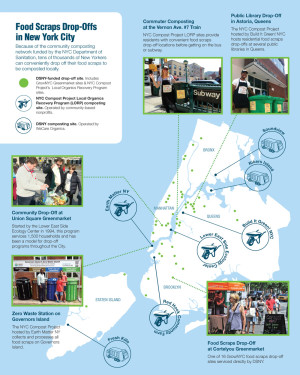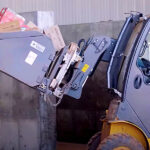A range of collaborative programs involving city agencies and community composters has helped increase the diversion of household food scraps. Part II
Nora Goldstein
BioCycle February 2014
This article series focuses on the past, present and future of urban community composting of food scraps and other organics diversion in New York City. The series is being written in collaboration with the New York City Department of Sanitation’s Bureau of Waste Prevention, Reuse and Recycling, as well as sister agencies.
Over the past three to four years, the New York City Department of Sanitation’s (DSNY) Bureau of Waste Prevention, Reuse and Recycling (BWPRR) has been experimenting with a number of models and partnerships to make food scrap drop-off sites more convenient and accessible for New York City residents in all five boroughs. These models include Greenmarkets®, subway commuter drop-off sites, public library-based drop-offs, and a Zero Waste Island initiative on Governors Island. The goal of all of these programs is to divert organics from the waste stream and simultaneously produce high quality finished compost that can be used for local greening projects. Partnerships that BWPRR has cultivated through its NYC Compost Project and city agencies strengthen the programs that help to make all of the drop-off sites flourish.
Part I of this article series (see “Community Composting In New York City,” November 2013) provided a history of community composting initiatives, and an introduction to current programs cultivated and managed under the auspices of BWPRR and its NYC Compost Project. We spoke with Robert Lange, Director of the Bureau of Waste Prevention, Reuse and Recycling, to learn more about the most well-known of these partnerships — the GrowNYC/DSNY Greenmarket Food Scrap Drop-Off Program. Our interview focused on understanding the evolution of the Greenmarkets drop-off program and how it has grown in size and scope from a small program run by a few community composters to a large-scale partnership involving city agencies and a range of nonprofit partners.
BioCycle: How did DSNY get involved in the Greenmarket Food Scrap Drop-Off Program?
BWPRR: Our involvement with the Greenmarket Food Scrap Drop-Off Program emerged as a natural extension of our NYC Compost Project activities. As discussed in Part I of this series, the NYC Compost Project was founded in 1993, and began as a straightforward compost outreach and education program. We hosted information tables, gave composting workshops and ran the NYC Master Composter Certificate Course. Our goal was to teach the public how to compost in both outdoor and indoor systems. As we grew the program, we began providing more overt technical assistance to community gardens, helping sites build 3-bin systems and sifters, and providing cranks and other basic tools for maintaining small-scale composting sites.
Over the years, community composting sites we supported matured. Some started to accept food scraps from the public and others developed a composting membership within their larger community garden structures. Composting memberships enabled nongarden members to compost their food scraps at the gardens in exchange for assisting with the compost site. Our Master Composters evolved as well, with some developing composting operations that were distinct from community gardens. Their focus was on capturing local organics, and they wanted to use all of the vacant city space they could identify to maximize processing capacity.
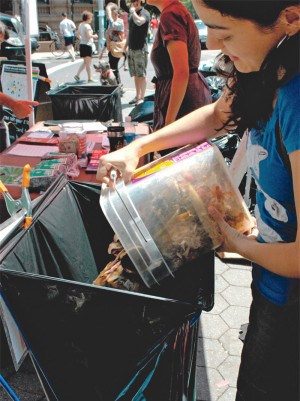
New York City residents have an opportunity to recycle food scraps at weekly Greenmarkets. Currently,
35 of the 54 Greenmarkets have
drop-off sites.
Some of these Master Composters began identifying highly visible and accessible public venues, (separate from their composting sites) for residents to drop off their food scraps. At the end of each drop-off, they would backhaul the material (often via bike) and process the organics at their neighborhood-based composting sites. The NYC Greenmarkets operated by GrowNYC was one of the most obvious food scrap drop-off locales for Master Composters, as Greenmarket consumers already demonstrated their willingness to forego the convenience of one-stop shopping in order to purchase local (and sometimes organic) foods. This indicated these same people might also be willing to carry their food scraps to a Greenmarket to be composted locally.
BioCycle: Was there a precedent for utilizing Greenmarkets to encourage recycling, especially of food scraps?
BWPRR: The Lower East Side Ecology Center (LESEC) has been accepting residential food scraps at the Union Square Greenmarket since 1994. By 2000, within six years of its founding, the LESEC had over 500 households dropping off, and was accepting 1.5 tons/week of material. By 2005, this number grew to 750 households.
Building off this success, the Fort Greene Compost Project, (driven by some committed Master Composters who were trained by DSNY’s NYC Compost Project), started accepting food scraps in October 2005 at Fort Greene Greenmarket in Brooklyn. The material was processed by four to five local community gardens, which agreed to participate in a monthly processing rotation. In 2007, a similar group was started by Master Composters in Queens (originally called Western Queens Compost Initiative and later solidified as Build it Green! (BIG!)Compost). It began accepting food scraps at three different Greenmarkets in Queens. Originally, these Master Composters processed that material at two to three Queens-based community gardens and urban farms. Today, all that material is processed at one central community composting site operated by BIG!Compost as part of the NYC Compost Project.
By 2010, the Fort Greene Compost Project started to receive more material at the Fort Greene Greenmarket than it could process. Several things were tried to alleviate the situation, including a pilot with a local grower who sold at that Greenmarket, and some initiatives explored by GrowNYC. The idea was to evaluate the option of the growers backhauling and processing the food scraps at their farms. However, ultimately the pilot arrangement didn’t work out for the grower.
BioCycle: What was GrowNYC able to do to assist the Fort Greene Compost Project?
BWPRR: GrowNYC’s Office of Recycling, Outreach and Education, (OROE), another DSNY-funded outreach program, was already aware of the popularity of these Master Composter-led food scraps drop-off programs. OROE decided to see if it could expand the Greenmarket drop-off program and streamline processing of materials collected.
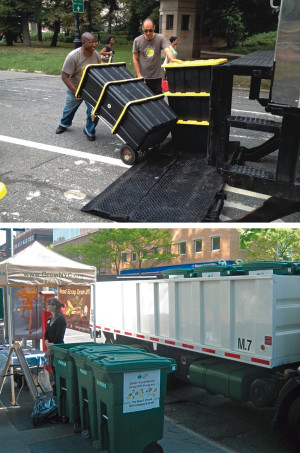
Both GrowNYC’s Office of Recycling, Outreach and Education (OROE) and DSNY transport food scraps dropped off at the Greenmarkets. OROE utilizes 27-gallon rectangular tubs and a box truck (top). DSNY uses 64-gallon Toters and a flat bed truck (bottom).
At this point, GrowNYC representatives approached the then New York City Council Speaker’s office about additional funding to pay a New York City-based carter to collect and transport the aggregated food scraps to a centralized composting facility. The Speaker’s office provided GrowNYC with two $45,000 grants to have Greenmarket pilot this idea. Starting in March 2011, Greenmarket began managing acceptance of organics at seven Greenmarket locations, including Fort Greene in Brooklyn. At first, OROE staffed the seven Greenmarket drop-offs, and the selected hauler, Action Carting, transported the food scraps to the Peninsula Compost Group in Wilmington, Delaware, 130 miles each way. The other four Greenmarkets — Union Square and the three sites in Queens — continued to be serviced by LESEC and what is now called BIG!Compost as part of the NYC Compost Project.
BioCycle: How sustainable was the long distance transport of Greenmarket food scraps?
BWPRR: GrowNYC/OROE knew the funds for the hauling to Peninsula Compost were going to run out before the end of 2011, so continuing long distance transport wasn’t going to be sustainable from that vantage point. And in the early development of the program, BWPRR decided as an agency that it made more sense to develop local composting capacity for the organic material rather than haul loads such a distance. Simultaneously, Erik Martig, then Program Manager of OROE’s food scraps drop-off program (and now Program Coordinator for BIG!Compost), was working with community composters to maximize the amount of material composted locally. Drawing on the Fort Greene Compost Project model, they developed a regular rotation through which food scraps accepted at several Greenmarket sites on Saturdays are delivered to a different community composting site each week. The material is composted with the help of dozens of volunteers on Sundays, and the finished product is used in local greening projects.
We were incredibly impressed by this system, and began talking to community composters in the spring of 2011 to see if we could help these sites increase their processing capacity within the limits allowed under current City and New York State Department of Environmental Conservation (NYSDEC) regulations. By the spring of 2012, we had a system in place to fund a few of the larger community composters (Earth Matter and BIG!Compost) through the NYC Compost Project. We chose to support those two groups as they had demonstrated a high level of proficiency managing urban-based composting systems, and wanted to grow their composting capacity and produce high quality compost for local greening projects. The NYC Compost Project has always been interested in rebuilding the City’s soil, neighborhood by neighborhood. These two groups could help us achieve those goals. With this expanded community capacity in place, the GrowNYC/DSNY Food Scraps Drop-Off Program was launched on April 21, 2012, adding 14 additional Greenmarkets to the seven begun as a pilot program — in addition to the sites serviced by LESEC and Big!Compost.
BioCycle: Was there any other composting capacity to tap into within New York City itself?
BWPRR: The DSNY did have institutional capacity at that time to manage the collection and processing of Greenmarket food scraps because of the pristine nature of the kind of material received at monitored drop-off locations. We had already experimented with the collection and transportation of food scraps from our Rikers Island in-vessel composting facility in Queens to another DSNY composting location during rehabilitation of the Rikers Island plant. Rikers Island houses the city’s largest correctional facility, and uses the IPS agitated bay system — managed by WeCare Organics. As a result, we had developed significant experience transporting and managing food scraps, maximizing efficiency and minimizing odors. I also was familiar with the type of carts used by Recology in San Francisco to service both residential and commercial customers for food scrap collection. So we set up our Greenmarket collection program in a similar manner based upon this experience.
BioCycle: How does DSNY service the Greenmarkets?
BWPRR: We purchased enough 64-gallon Toters for all of the 16 Greenmarket drop-off sites serviced by DSNY. The Toters are housed at our main composting facility on Staten Island. The carts are filled with a foot of fine mulch before being taken to a Greenmarket drop-off site. The mulch soaks up any of liquids that might seep out of the food scraps while the Toters are at the Greenmarket or being collected and transported by DSNY personnel. The mulch also helps eliminate odors. The DSNY delivers and collects the Toters using a flat bed truck from each drop-off site at the end of each market day. The truck can hold anywhere from 18 to 20 Toters. OROE staffs the drop-off locations that are serviced by DSNY and ensures that residents deposit only clean organics.
Originally, the DSNY-collected Greenmarkets food scraps were taken to the city’s Fresh Kills composting facility. The food scraps were unloaded directly into a pile of wood chips and then covered with more wood chips. The material was then blended and capped with a final cover of wood chips. Empty Toters were power washed, set out to dry, and filled with 12-inches of fine mulch before going to their next Greenmarket location.
Unfortunately this system was disrupted when local elected officials in Staten Island objected to out-of-borough food scraps being incorporated into the windrow composting facility at Fresh Kills. Though DSNY is permitted to accept organics from all of New York City, it was asked to use another composting site so as not to deliver out-of-borough food scraps to Staten Island, which until its closure, was the home of New York City’s largest landfill.
BioCycle: What options were left for DSNY at this point for the Greenmarket food scraps it was collecting, other than going back to long distance transport?
BWPRR: We were forced to find another way to process Greenmarket food scraps, as there was no other composting site managed by DSNY that was permitted to accept them and also had the capacity needed. DSNY worked out a temporary solution with representatives of the NYSDEC to haul the food scraps to Rikers Island in Queens.
Subsequently, an interesting pilot project was initiated between DSNY, the city’s Department of Environmental Protection (DEP) — which operates all of the city’s wastewater treatment facilities — and Waste Management (WM). Waste Management offered to accept, at no cost, the contaminant-free Greenmarket food scraps at its Varick I facility in Brooklyn, grind them into a slurry and then transport the material across the street to the DEP Newtown Creek wastewater treatment plant. (Originally some food scraps collected from New York City schools were going to the WM facility, but due to contaminants, that material is no longer taken to that operation.) The DEP is testing the slurry as a feedstock for its anaerobic digester. All food scraps from the 16 Greenmarkets serviced by DSNY will be slurried and added to the WWTP digester. The Greenmarket material meets purity requirements of the equipment that produces the slurry (no nonorganics) and the type of organics acceptable to the treatment plant digester (high sugar content). The pilot is scheduled to conclude at the close of the City’s fiscal year, June 30, 2014.
BioCycle: How many Greenmarkets have food scraps drop-off programs? And of those, how many are serviced by DSNY versus the community composters?
BWPRR: With DSNY’s involvement, the number of sites in the Greenmarket drop-off program tripled by the spring of 2013 — from 11 to a total of 35 Greenmarket drop-off sites. There are 54 Greenmarkets in New York City, so that means that over half (64%) are outfitted with a drop-off program! Today, DSNY is directly involved with dropping off and collecting the Toters and processing the material from 16 of the 35 drop-off sites. Our selection of Greenmarkets to be serviced is a function of DSNY building workable routes using sites that generate larger amounts of food scraps and working with OROE and the community composters to have the route outliers and smaller generators handled by them. One of the 35 markets is wholly managed by the Lower East Side Ecology Center and four of the 35 markets are wholly managed by BIG!Compost, which is funded and managed as part of DSNY’s NYC Compost Project. And organic material from the remaining 15 markets is collected by OROE and delivered for processing, at times, by organizations funded and managed by DSNY, including BIG!Compost, Added Value’s Red Hook Community Farm and Earth Matter.
BioCycle: Is the collection system the same as DSNY’s?
BWPRR: For the most part, food scraps that are going to be processed by community composters are collected in 27-gallon rectangular tubs. OROE uses a box truck with a liftgate to transport the filled tubs to the community composting sites. OROE prefers the tubs because they are lighter and easier for its staff to transport. Many of the community composting sites organize volunteer days around the Greenmarket food scraps drops as a way to further engage the New York City public in composting.
BIG!Compost tips the rectangular tubs into a JayLor mixer and then adds the blended material to its aerated static piles. This is an interesting innovation, as the JayLor is more commonly used to mix feed on cattle farms. In this way, community composters are adopting agriculture equipment for use in small-scale urban composting operations.
BioCycle: Exactly how much food scraps are diverted through the Greenmarket program?
BWPRR: There is a weekly log documenting pounds collected per route, tons collected per route and, for DSNY- managed sites, the number of trucks used per route. All stats come to BWPRR, since we are funding the bulk of the parties involved in this effort. DSNY collected and processed 233.10 tons of food scraps from Greenmarkets in FY13, or almost 500,000 pounds. This averages to 2.43 tons or 4,600 pounds/week. OROE collected 239.5 tons of food scraps in the same period that were delivered to local community composters, including but not limited to Big!Compost, Earth Matter, Red Hook Farm and Project EATS. Most of these sites cannot accept the amount generated per week, so their acceptance is on a rotating basis based upon available capacity.
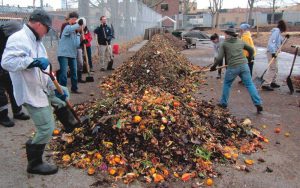
Many of the community composting sites, such as Added Value’s Red Hook Community Farm, organize “windrow building” volunteer days around the Greenmarket food scraps drops.
BioCycle: What stands out most in BWPRR’s mind with regard to the success of the Greenmarket program?
BWPRR: The Greenmarket program is most noteworthy in its ability to tap into a self-selected group of highly motivated and committed individuals. These New Yorkers are willing to source separate and store their organics, bringing them on select days to their local Greenmarket drop-off site. OROE staff further ensure that the organics received from the public are pristine in nature and therefore require no preprocessing to make them available for producing a very high quality compost.
As a City agency, the quality of the material and efficiency of the collection routes are critical. This is because cost per ton is the major management indicator by which we are judged. Unfortunately, in the past when we have attempted to collect organics curbside, the food scraps set out was of an insufficient quantity and had high levels of nonorganic contaminants, making it complicated to process the material into a high quality compost. This made it hard to justify adding another truck and its correlating emissions to New York City’s already heavily traveled roadways. Though we are again piloting curbside collection of food scraps from residential dwellings, we have not experienced as of yet and do not expect to experience receipt of the same quality of organics that can be accepted at monitored drop-off locations.
BioCycle: What are some key milestones of the Greenmarket program?
BWPRR: Many wonderful things have emerged out of this program, from neighborhood awareness to intra-agency collaborations. However, what we find most exciting is our work with the community composters. Many of these sites were started by Master Composters as fledgling operations. They were using a series of tumblers, Garden Gourmets or manually aerated pallet bin systems. These sites are now more sophisticated in their operations and are helping us to define best practices for mid-scale urban composting. We are using their experiences to help us think through how to best grow the NYC Compost Project as the community composters test out new techniques and new frontiers in urban composting.
In addition, while Greenmarkets are a great start for drop-off sites, they only capture one segment of the food scraps from the City’s population. In the spring of 2013, we brought on two more organizations as part of the NYC Compost Project — the Lower East Side Ecology Center and Added Value’s Red Hook Community Farm. Both of these sites, as well as BIG!Compost and Earth Matter, are expanding their drop-off sites to service areas other than Greenmarkets.
Ultimately, while the Greenmarkets have been the catalyst and provide a good amount of clean feedstock, there are tons of other locales to tap. We believe that neighborhood-based operations are the most ecologically and economically efficient means for processing local food scraps. And it is our goal to support this work and plough the finished material back into neighborhood greening.



